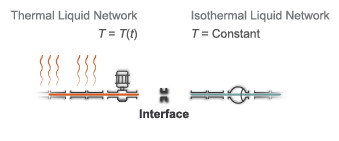Interface (TL-IL)
Connection between thermal and isothermal networks
Libraries:
Simscape /
Fluids /
Fluid Network Interfaces
Description
The Interface block is a connector between thermal and isothermal fluid networks. The fluid mass flow rate and pressure are matched between the networks, but fluid properties are not passed between the two networks. To maintain fluid properties between the thermal and isothermal components of your model, connect an Isothermal Liquid Predefined Properties (IL) block with the desired properties to the isothermal network side.
You can connect Thermal Liquid library blocks with Isothermal Liquid library or
Hydraulics (Isothermal) library blocks. The temperature set in the isothermal system can
either be Constant or Controlled.
In the case of a Controlled temperature system, the
isothermal network temperature is set by the thermal liquid temperature. In the
Constant temperature setting, you specify the isothermal
network temperature directly.

Thermal Liquid - Isothermal Liquid
When Fluids domain interface is set to Thermal Liquid
(TL) - Isothermal Liquid (IL), the mass flow rate is conserved
over the two mass-flow-rate-based networks:
where:
TL is the mass flow rate at the thermal liquid interface.
IL is the mass flow rate at the isothermal liquid interface.
The fluid absolute pressure is maintained between the thermal, internal, and isothermal sections of the Interface block:
Thermal Liquid - Hydraulics (Isothermal)
The Hydraulics (Isothermal) Liquid library is based on volumetric flow rate. To maintain flow continuity between both sides of the interface, the volumetric flow rate is multiplied by the fluid density:
where:
qH is the Hydraulics (Isothermal) volumetric flow rate.
ρH is the local Hydraulics (Isothermal) fluid density.
The Hydraulics (Isothermal) Liquid library blocks are constructed in terms of gauge pressures. Pressure is converted to absolute pressure internally to match the thermal network pressure:
Ports
Conserving
Parameters
Extended Capabilities
Version History
Introduced in R2020a
